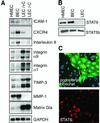Lymphatic endothelial reprogramming of vascular endothelial cells by the Prox-1 homeobox transcription factor
- PMID: 12198161
- PMCID: PMC125413
- DOI: 10.1093/emboj/cdf470
Lymphatic endothelial reprogramming of vascular endothelial cells by the Prox-1 homeobox transcription factor
Abstract
Lymphatic vessels are essential for fluid homeostasis, immune surveillance and fat adsorption, and also serve as a major route for tumor metastasis in many types of cancer. We found that isolated human primary lymphatic and blood vascular endothelial cells (LECs and BECs, respectively) show interesting differences in gene expression relevant for their distinct functions in vivo. Although these phenotypes are stable in vitro and in vivo, overexpression of the homeobox transcription factor Prox-1 in the BECs was capable of inducing LEC-specific gene transcription in the BECs, and, surprisingly, Prox-1 suppressed the expression of approximately 40% of the BEC-specific genes. Prox-1 did not have global effects on the expression of LEC-specific genes in other cell types, except that it up-regulated cyclin E1 and E2 mRNAs and activated the cyclin e promoter in various cell types. These data suggest that Prox-1 acts as a cell proliferation inducer and a fate determination factor for the LECs. Furthermore, the data provide insights into the phenotypic diversity of endothelial cells and into the possibility of transcriptional reprogramming of differentiated endothelial cells.
Figures





References
-
- Ebata N., Nodasaka,Y., Sawa,Y., Yamaoka,Y., Makino,S., Totsuka,Y. and Yoshida,S. (2001) Desmoplakin as a specific marker of lymphatic vessels. Microvasc. Res., 61, 40–48. - PubMed
-
- Giancotti F.G. and Ruoslahti,E. (1999) Integrin signaling. Science, 285, 1028–1032. - PubMed
-
- Goebeler M., Schnarr,B., Toksoy,A., Kunz,M., Brocker,E.B., Duschl,A. and Gillitzer,R. (1997) Interleukin-13 selectively induces monocyte chemoattractant protein-1 synthesis and secretion by human endothelial cells. Involvement of IL-4Rα and Stat6 phosphorylation. Immunology, 91, 450–457. - PMC - PubMed
Publication types
MeSH terms
Substances
LinkOut - more resources
Full Text Sources
Other Literature Sources
Molecular Biology Databases
Research Materials

